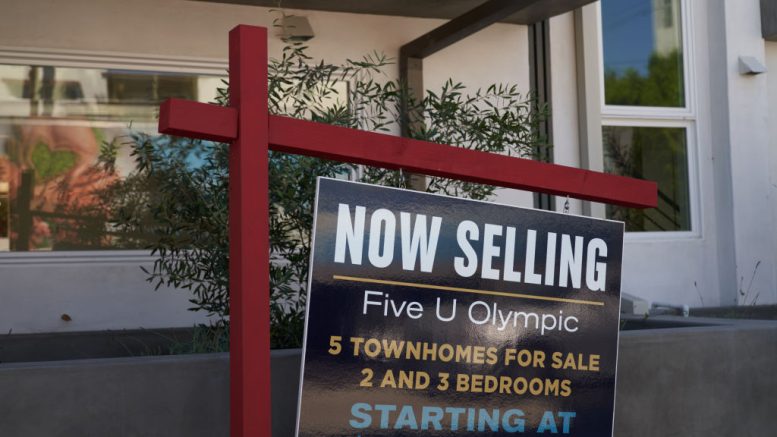Multiple efforts to boost housing construction are meant to bring home ownership back within reach. Meanwhile, workers can’t keep up.
By Mark Kreidler, Capital & Main
This story is produced by the award-winning journalism nonprofit Capital & Main and co-published here with permission.
California’s housing crisis, an issue in the works for at least five decades, reached a crescendo of sorts over the past four years. Escalating prices, driven by the ongoing lack of supply, combined with spiking interest rates to drive up housing costs to untenable new levels.
A recent report by the state Legislative Analyst’s Office puts numbers to these realities, and the result is chilling. According to the nonpartisan LAO, a bottom-tier home in California — one that falls within the 5th to 35th percentile of home values here — costs 33% more than a mid-tier home in the rest of the country.
Apples to apples, a mid-tier home, in the 35th to 65th percentile of home values, costs more than twice as much in California as elsewhere in the U.S. — $784,000, versus $354,000 nationally. This translates to a budget-choking average monthly payment for Californians of nearly $6,000.
Comparatively high home prices in the Golden State are not new, of course. But from January 2020 to March 2024, the LAO found that payments for a mid-tier home here rose by 80%. For a bottom-tier home, payments rose by even more, 86%.
The growth in average hourly wages during that same time: 18%.
The upshot of this dynamic, the analyst’s report said, is that to qualify for a mortgage on a mid-tier home in California, a buyer would need an annual income of roughly $235,000. That’s two and a half times the median household income for 2022, the most recent year of data available. To even scrape for a bottom-tier home, you’d need to make $140,000 a year to qualify for the mortgage, the LAO said.
That is a lot of numbers to tell a cold truth: Working-class Californians can’t afford homes. They are increasingly priced out of the market. And with monthly rents running above $2,800 for a two-bedroom — and way higher than that in the state’s largest cities — their ability to save toward a “someday” home purchase is becoming a distant notion.
* * *
Given all that we know, it’s obvious that there is no single-source solution to the sprawling and complex issue of affordability in California. The state doesn’t control interest rates, which shot up from about 2.7% for a 30-year fixed-rate mortgage in January 2021 to 7.8% in October 2023 before finally beginning to recede, and it’s safe to say that wage earners won’t be getting the kinds of raises that would offset 80% hikes in house payments.
But housing supply is an area that both government and private industry can directly affect — and it’s basically the ballgame, many experts believe. The state needs to be digging into all of its available options, which, it turns out, are plentiful.
While running for governor in 2017, Gavin Newsom pledged on social media to “lead the effort” to build 3.5 million new housing units by 2025. In April of this year, Newsom’s office said the state now must plan 2.5 million new homes by 2030, a revision of sorts and a fair encapsulation of what a moving target housing is.
In an all-hands-on-deck situation, every approach matters, and Newsom’s administration has one in place that’s worth a look. By bestowing a “prohousing” designation on communities or entire counties, the state opens access to exclusive grants and an edge in gaining additional funding through the Department of Housing and Community Development.
In April, Newsom’s office added Berkeley, Brea, Crescent City, Fairfield, Pinole, Rancho Cucamonga, Richmond, South Lake Tahoe and West Hollywood, along with the County of Los Angeles, to a statewide prohousing list that it said now stands at 47.
The cities and L.A. County were rewarded for doing things like accelerating housing production, reducing construction costs and generally fast-tracking the removal of obstacles to housing development, such as zoning issues. Newsom’s office also places a premium on the building of affordable housing, as it counts the need for at least 1 million of the homes built by 2030 to serve lower-income Californians.
“At nearly 50 prohousing communities, California is making progress — but we can do better,” Newsom said in the statement recognizing the April additions to the list. “At a time when the state is facing a housing crisis, every local jurisdiction should be stepping up to earn this distinction.”
* * *
The state effort is one spoke on the wheel of possible solutions. Other inventive approaches need to be recognized and rewarded, such as the $12.7 million Newsom directed to the city of San Jose to build up to 200 tiny homes for the city’s unhoused residents.
Project Homekey, another effort to reduce homelessness, surpassed 15,000 units earlier this year. In San Francisco, realtors say people are increasingly using tenancy in common, a legal designation that allows unrelated parties to purchase percentages of a home, as a way to get into the housing ownership market that otherwise locks them out financially.
A program in Santa Barbara County is exploring using 3D printing to build more affordable housing faster. More than 80,000 accessory dwelling units, meanwhile, have been permitted since 2016, likely pushing the total of ADUs in the state well beyond 100,000. Counties are looking to expand community land trusts to create more housing that people can afford.
There is, of course, no silver bullet. As the Legislative Analyst’s Office report makes clear, California’s housing crisis has deepened dramatically in just the past four years. But just as that crisis is a thing that exists on multiple levels, so must the efforts to solve it. These are starts.
Copyright 2024 Capital & Main


Be the first to comment on "California’s home costs have run away from working-class residents"